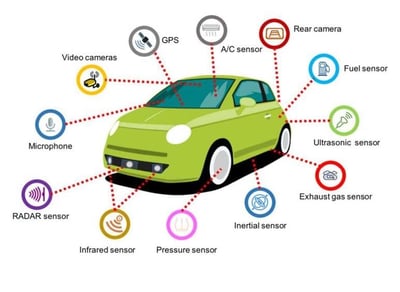Sensors: Filling the gap between Karl Benz and driverless vehicles
by JC Kocjancic, on Oct 25, 2022 4:35:40 PM
In July 1886, Karl Benz drove the first automobile “off the lot” in Mannheim, Germany. It had a whopping top speed of 10 mph.
Today, the US automotive industry stands at level two, just a few steps away from fully driverless vehicles, according to the Society of Automotive Engineers’ (SAE) six levels of driving automation.
One of the most dramatic advancements in transportation over the last few decades has been sensor technology.
Temperature, humidity, position, tilt, pressure, weight—sensors continually monitor and collect data about these and other environmental and mechanical factors. Sensors are central to the Internet of Things (IoT) revolution, serving as part of the real-time exchange of information between people and devices.
Sensors: Improving vehicle safety
One of the earliest applications of sensors in transportation was a simple circuit that triggered an alert in response to low oil pressure. That was in the 1950’s. In the last three decades, sensor technology has exploded, supported by their precision and reproducibility of output.
Federal regulations and customer expectations have spurred the standard inclusion of sensors for rearview visibility, emission performance, seatbelt use, tire pressure, and other maintenance issues.
And the market demand is increasing rapidly for sensors that detect objects and their distance from a vehicle, a feature that figures prominently in parking assistance and collision-mitigation systems.
Today, the average number of sensors in a vehicle is approaching 100, with some "smarter” cars having as many as 200 sensors.

Sensors: Building a transportation infrastructure
Each year, the federal government invests 1.6 percent of the nation’s Gross Domestic Product (GDP) into the transportation infrastructure. This investment supports the integration of intra-vehicular sensors with a broader transportation infrastructure.
This “smart” transportation infrastructure is revolutionizing driver safety, traffic control, and environmental impact.
Driver safety: Sensors are a vital component of monitoring air temperature, precipitation, and other risk-increasing conditions such as fog, smoke, potholes, and speed bumps.
Traffic control: Sensors detect traffic light queues, the number and classification of vehicles, road conditions, and other factors that contribute to traffic congestion, travel delays, and fuel waste.
Environment: Sensors are becoming integral to an environmentally friendly transportation infrastructure, monitoring crucial factors such as carbon dioxide emissions.
Sensors: Monitoring driver impairment
Sensor technology is developing quickly, with a growing potential to monitor impaired driver performance resulting from fatigue, alcohol level, or an unstable emotional state. (More than half of all traffic fatalities result from driver impairment, including drowsy driving, drunk driving, and driver distractions.)
Sensors can be used to monitor:
- head position that could indicate impaired driving
- steering angles to detect erratic driving behavior
- heart rate, blood pressure, respiration, impaired emotional state, high stress, and other measures that indicate the need for emergency medical intervention
Sensors: Design and manufacturing
While sensors can support complex functions, their designs are relatively simple. They consist of single- or multi-stack circuits produced when functional inks are printed on flexible substrates, such as polymers, plastic, textiles, and fabrics.
Incorporating sensors into product design provides:
- elimination of rigidity and bulk
- immediate response to stimuli
- lightweight, portable, stretchable, and disposable design options
- opportunity for mass-production
- real-time feedback to users or remote monitors
- reliable and reproducible data
If you are considering the inclusion of sensors in one of your company’s products, The Cubbison Company can assist with your decision and your design.
In discussing your product design, we will ask you to consider:
- end-user interaction
- functional ink to direct the flow of electricity
- multi- or single-layer circuit construction
- need for mass production
- printing technique
- purpose and environment
- size restriction
- substrates
The use of sensors has pivoted the science of user-interface printed electronics toward life-changing solutions in the transportation, defense, agriculture, industrial power, and other sectors.
The Cubbison Company has manufactured sensors for clients in each of these industries, including the following applications:
Transportation: The Cubbison Company manufactures sensor-driven touchscreens that serve as the human-machine interface in automobile consoles.
Medical Device: We manufactured a sensor that can detect the amount and points of pressure resulting from an individual's posture in a wheelchair. The sensor records how weight is distributed across the surface area of the wheelchair, and that data is used to notify the caretaker that the person needs to be repositioned to prevent blood clots.
Sports and Entertainment: The Cubbison Company engineered a sensor that could be used as part of a virtual golf training system. We worked with the client to build a force sensing resistor (FSR) that can detect weight and visually share that information with golfers in real time to help them adjust their stance.
Email salesengineer@cubbison.com or call 800-733-4133 to discuss a sensor design that will satisfy your product design needs.
We can also discuss the value of prototyping your sensor:
- Learn about prototype options available through The Cubbison Company.
- Read The Cubbison Company’s blog on the importance of using prototypes to validate design decisions.
Image source: https://www.ncbi.nlm.nih.gov/pmc/articles/PMC5948625/




